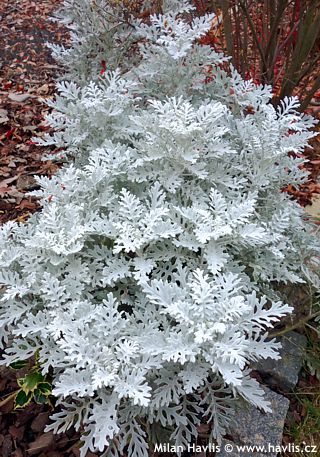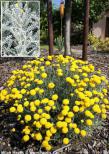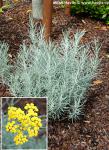Jacobaea maritima

Jacobaea maritima
silver ragwort, dusty miller
silver ragwort, dusty miller
| SIZE/TYPE | low perennial |
|---|---|
| USUAL HEIGHT | 0.3-0.6m |
| USUAL WIDTH | 0.3-0.4m |
| LEAVES | evergreen broadleaf |
| COLOUR OF LEAVES |
 + + multicoloured:silver and silvery-blue multicoloured:silver and silvery-blue |
| FLOWERS | insignificant or non-blooming |
| LOCATION | full sun |
| SOIL TYPE | any (acidic to alkaline) |
| SOIL MOISTURE REQUIREMENTS | dry and sharply drained (xeriscape) |
| USDA zone (lowest) | 7 (down to -18°C) |
| WINTER PROTECTION | |
| FOR ZONE 5+6 |

|
| FOR ZONE 7 |

|
| BELONGS TO CATEGORIES |
Perennials Evergreen broadleaf Exotics |
Silvery leaves in perennial beds bring the exotic feeling of hot southern summers and at the same time create a perfect contrast to all the other leaves in the common colours like green, yellow or glaucous. Next to famous lavenders, this group contains for example santolina, helichrysum, artemisia, and some species of centaurea or silene. Some of them are all generally called dusty miller just like this one that has recently been renamed from Senecio cineraria to Jacobaea maritima. Are you saying that you surely know this plant as an annual? Well, keep on reading and get ready for a surprise.
Silver ragwort comes from the Mediterranean basin and its home is in all South-European countries, as well as North Africa, Turkey, and Greece. It makes woolly, evergreen leaves which are densely covered with the finest silvery grey indumentum that nature invented. Their colour is dark green, yet it is almost invisible thanks to the rich portion of silver hairs. They are incised so delicately that they look like Brussels lace when mass planted. And from up close they resemble antlers of a young deer.
There are several varieties that differ in leaf shape, size, or colour. Very successful is the Silver Dust variety with particularly bright leaves and lower growth. In England, it received the AGM (Award of Garden Merit) for beauty and reliability from the Royal Horticultural Society (RHS). We have not trialled large-leaved varieties yet.
In its native habitat, silver ragwort is a subshrub forming a woody base, growing to less than one meter in height and about half in width as soon as it starts branching out from the second year. In Central European climate, for many years, it was only considered and sold as an annual. But sometimes someone didn't know it, planted it in the garden and lo and behold, it kept on growing even after winter. Surprises often rise from ignorance, so I planted a few of them, too, and it really worked. So far they have withstood -19 °C with the longest life span of 5 years. It may seem short-lived, but given its usually low purchase price, it's always a great buy bringing a lot of excitement to your garden.
Jacobaea loves full sun and can only tolerate a very light partial shade. It copes with heat, wind, drought, and sea salt and requires a well-drained bed with normal or even poor soil. It will even grow on a sandy loam. There is no need for a winter cover so you can enjoy its beauty all year round without virtually no maintenance. Just remove a few old unsightly leaves in spring. There is no need to cut, but overgrown plants can be rejuvenated by hard pruning to a solid framework. The hardiness described above will only work under the growing conditions listed here, and only if planted in the garden – it does not usually survive in outdoor pots after winter.
Last update 06-10-2023
Silver ragwort comes from the Mediterranean basin and its home is in all South-European countries, as well as North Africa, Turkey, and Greece. It makes woolly, evergreen leaves which are densely covered with the finest silvery grey indumentum that nature invented. Their colour is dark green, yet it is almost invisible thanks to the rich portion of silver hairs. They are incised so delicately that they look like Brussels lace when mass planted. And from up close they resemble antlers of a young deer.
There are several varieties that differ in leaf shape, size, or colour. Very successful is the Silver Dust variety with particularly bright leaves and lower growth. In England, it received the AGM (Award of Garden Merit) for beauty and reliability from the Royal Horticultural Society (RHS). We have not trialled large-leaved varieties yet.
In its native habitat, silver ragwort is a subshrub forming a woody base, growing to less than one meter in height and about half in width as soon as it starts branching out from the second year. In Central European climate, for many years, it was only considered and sold as an annual. But sometimes someone didn't know it, planted it in the garden and lo and behold, it kept on growing even after winter. Surprises often rise from ignorance, so I planted a few of them, too, and it really worked. So far they have withstood -19 °C with the longest life span of 5 years. It may seem short-lived, but given its usually low purchase price, it's always a great buy bringing a lot of excitement to your garden.
Jacobaea loves full sun and can only tolerate a very light partial shade. It copes with heat, wind, drought, and sea salt and requires a well-drained bed with normal or even poor soil. It will even grow on a sandy loam. There is no need for a winter cover so you can enjoy its beauty all year round without virtually no maintenance. Just remove a few old unsightly leaves in spring. There is no need to cut, but overgrown plants can be rejuvenated by hard pruning to a solid framework. The hardiness described above will only work under the growing conditions listed here, and only if planted in the garden – it does not usually survive in outdoor pots after winter.
Last update 06-10-2023
SIZES and PRICES
CURRENTLY SOLD OUT
GLOSSARY
|












